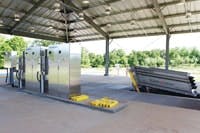The city of Auburn, Ala., has two wastewater treatment facilities: the Northside Water Pollution Control Facility and the H.C. Morgan Water Pollution Control Facility. In 2012, the H.C. Morgan facility was upgraded and disinfection was converted from chlorine to ultraviolet (UV). This case study will provide details about the chlorine to UV conversion process, and why the TrojanUVSigna was chosen.
The city of Auburn is a thriving community of approximately 56,900 residents. It is a college town and the home of Auburn University, which has an enrollment of more than 25,000.
Auburn sits near the divide between the Chattahoochee and Tallapoosa River watersheds. It is also divided into two sewer service basins, the Northside basin and the H.C. Morgan (or Southside) basin. The city has two treatment facilities: the Northside Water Pollution Control Facility (WPCF) which has a permitted capacity of two million gal per day (mgd) (315 cu meters per hour) and the H.C. Morgan WPCF which has a permitted capacity of 11.25 mgd (1,772 cu meters per hour). The plants were originally constructed in 1985 and were the first privatized plants in Alabama. The city owns these plants and currently has operations contracts with Veolia Water North America.
In April 2008, the U.S. Environmental Protection Agency (EPA) and the Alabama Department of Environmental Management (ADEM) finalized a total maximum daily load (TMDL) for the Saughatchee Creek Watershed, which is where effluent from the Northside WPCF discharges. The TMDL established a total phosphorus (TP) waste load allocation of 0.25 mg/L for the Northside WPCF, requiring a 90% reduction in TP for the facility.
Subsequently, the city hired CH2M Hill to evaluate options for compliance with the TMDL. Two options were considered:
- 1. Upgrading the Northside WPCF to be able to meet the TP discharge requirements; and
- 2. Ceasing discharge at the Northside WPCF, utilizing a recently constructed transfer sewer system to pump everything to the H.C. Morgan WPCF and upgrading the H.C. Morgan WPCF to handle the additional flow.
After extensive analysis, the second option was selected. The H.C. Morgan WPCF is an activated sludge/extended aeration plant, utilizing both mechanical and biological treatment. It treats the majority of the sanitary wastewater for the city, and discharges to Parkerson Mill Creek. The site is approximately 40 acres and is located in an urban setting.
Finding a Solution
As part of the H.C. Morgan WPCF plant upgrade in 2012, the city decided to convert from chemical (chlorine) disinfection to environmentally friendly disinfection with UV. This conversion not only enables the city to benefit from UV’s safety and environmental advantages but also from the long-term savings in operation and maintenance costs. The city had been disinfecting with gaseous chlorine and dechlorinating with sulfur dioxide.
With their consultant, CH2M Hill, the city evaluated UV disinfection manufacturers and products. The H.C. Morgan WPCF, selected the TrojanUVSigna for its exclusive benefits, including:
- • Suitability for seasonal operation;
- • Lowest number of UV lamps required and ease of operation and maintenance;
- • Low total installed capital cost and long-term operating cost;
- • System design features and Trojan’s overall experience and support;
- • Simple retrofit installation into the existing chlorine contact chamber; and
- • Simplicity of operation and maintenance.
The TrojanUVSigna installation in Auburn was brought online in October 2012, just in time for college football season and the resulting population swell to the city. The system was designed with two 22 lamp banks (expandable to 29) to treat a peak capacity of 34.2 mgd. The TrojanUVSigna incorporates the latest features including: the TrojanUV Solo Lamp technology, advanced control capabilities, ActiClean automatic sleeve cleaning and an automatic raising mechanism which has simplified maintenance and operation for plant operators. Since startup, the system at Auburn has consistently performed under the regulated disinfection limit and the site has enjoyed minimal maintenance during the first year of operation.
“From concept to design to construction to system operation, Trojan has worked tirelessly to ensure that we were given a UV system that meets our needs,” says Matt R. Dunn, watershed division manager/project manager with the city of Auburn. “The TrojanUVSigna system has exceeded our expectations in all aspects and the staff at Trojan have been a pleasure to work with throughout this entire process.”
When converting from chlorine to UV, existing chlorine contact tanks are often used for a retrofit. This is the approach Auburn took; not only does it reduce construction costs, it also enables the surplus areas within old chlorine contact tanks to be used for water storage, bypass and other purposes.
The TrojanUVSigna system is specifically designed for large-scale wastewater disinfection applications, makes conversion to UV disinfection easier, reduces total cost of ownership compared to chemical disinfection and simplifies maintenance for the wastewater treatment plant operations staff.



